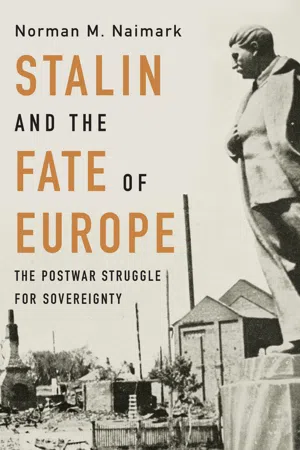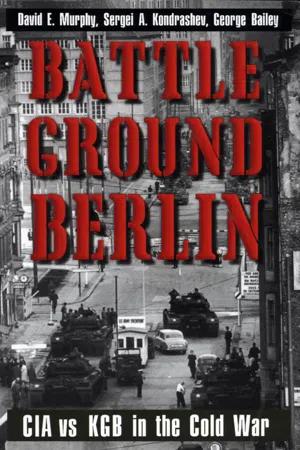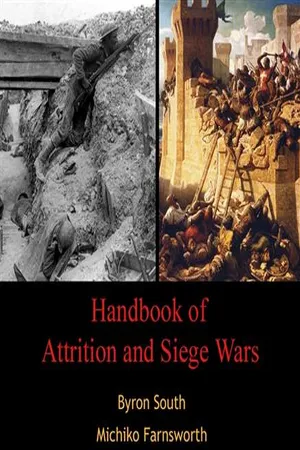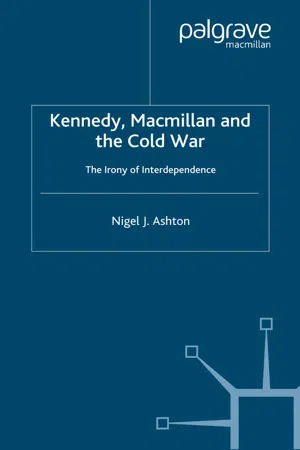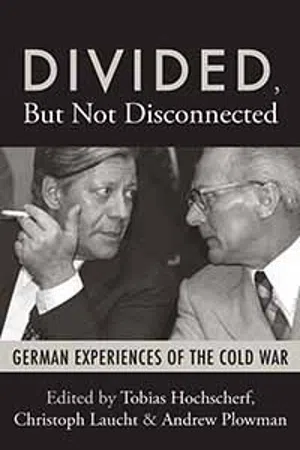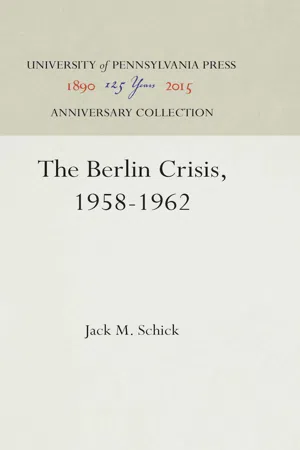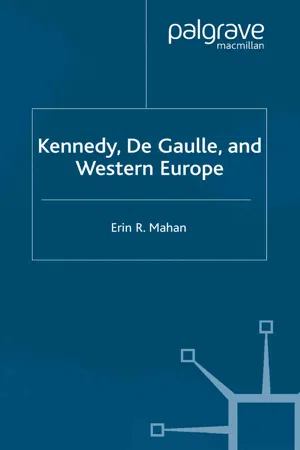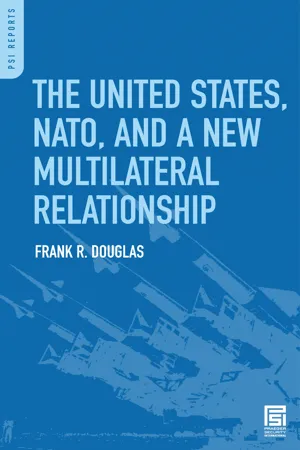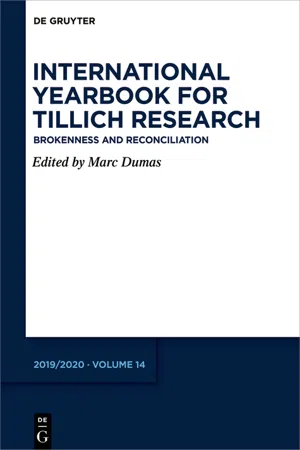History
The Berlin Blockade
The Berlin Blockade was a Soviet attempt to block Western access to West Berlin from June 1948 to May 1949. In response, the Western Allies organized the Berlin Airlift, delivering food and supplies to the city by air. The blockade heightened Cold War tensions and ultimately ended when the Soviets lifted the blockade.
Written by Perlego with AI-assistance
Related key terms
1 of 5
10 Key excerpts on "The Berlin Blockade"
- eBook - PDF
Stalin and the Fate of Europe
The Postwar Struggle for Sovereignty
- Norman M. Naimark(Author)
- 2019(Publication Date)
- Belknap Press(Publisher)
157 chapter five The Berlin Blockade 1948 – 1949 The history of The Berlin Blockade provides inspiring images of cowboy pilots dropping candy to the wide-eyed eager children of Berlin, of brave Berliners hovering around their cooking stoves for the two nighttime hours a day they had for using electricity, and of the U.S. Commander General Lucius Clay looking every bit as worn and gaunt as the hungry population he sought to feed through the miraculous airlift. There is no question that such a dramatic portrayal of the blockade and airlift (“Operation Vittles,” as the pilots dubbed it) captures important aspects of this seminal crisis of the early Cold War.1 Yet these popular images can easily obscure the role of the blockade in the development of Soviet policy in Germany. Perhaps more im-portantly, they can lead us to neglect the significance of the German reaction to Soviet initiatives on the continent. During the blockade, the Western Allies—and the Americans in particular—committed them-selves to the maintenance of West Berlin as an outpost in the middle of Soviet-controlled eastern Germany, a commitment that turned Berlin into a flashpoint for Cold War tensions on the European conti-nent for decades to come. On the heels of the lifting of the blockade, on May 23, 1949, the Federal Republic of Germany (“West Germany”) was created, and, almost in lockstep thereafter, on October 7, 1949, the German Democratic Republic (“East Germany”). These were not just administrative and legal state entities but two separate societies of survivors of a terrible dictatorship and a ruinous war that had defiled the German people and destroyed their cities, the families, and their livelihoods. 158 . stalin and the fate of europe There may be some exaggeration in General Curtis LeMay’s descrip-tion of the Germans’ situation when he arrived in Berlin in fall 1947. - eBook - PDF
Battleground Berlin
CIA vs. KGB in the Cold War
- David E. Murphy, Sergei A. Kondrashev, George Bailey(Authors)
- 2008(Publication Date)
- Yale University Press(Publisher)
3 The Berlin Blockade Challenges Western Ingenuity and Perseverance I always regarded the blockade as a miscalculation by the Russians. They wanted to see how far they could go, and they went too far. —PETER SICHEL, deputy chief of BOB A s the East Germans became more resentful of Soviet occupa-tion policies, and as disagreements between the former Allies intensified, sporadic Soviet harassment of land vehicles and airplanes entering West Berlin evolved into a blockade and sparked fear of war. Although the Soviets called the blockade a response to Western actions on currency reform, it soon became a test of Western determination to remain in Berlin. The feeling among West-ern leaders that Czechoslovakia had been lost as a free nation and that they were being strong-armed in Berlin made them determined to cre-ate a West German state that would be part of a European defense and would sustain close emotional, economic, and juridical ties with West Berlin. Intelligence played a key role in determining each side's posi-tion throughout this crisis. Although BOB'S reports on Soviet and East German military capabilities and intentions allayed Western fears of war, extensive Soviet intelligence on Western resolve to remain in Berlin did not deter Stalin until a massive airlift of food and supplies into West Berlin, never foreseen or reported by KI, caused him to lift the block-ade. The intelligence aspects of the blockade as seen from both sides have never before been revealed. 51 52 • The Sides Line Up The Soviets Prepare for a Showdown The year 1947 ended as had 1945, with SMA moving openly to remove leaders of the Soviet zone Christian Democratic Party (CDU). When Marshal Zhukov undermined the CDU leaders in December 1945, news of his action, reported by BOB, warned of Soviet intentions that many found difficult to believe but impossible to ignore. - No longer available |Learn more
- (Author)
- 2014(Publication Date)
- College Publishing House(Publisher)
________________________ WORLD TECHNOLOGIES ________________________ Chapter 9 Berlin Blockade Berliners watching a C-54 land at Tempelhof Airport (1948) The Berlin Blockade (24 June 1948 – 12 May 1949) was one of the first major international crises of the Cold War and the first resulting in casualties. During the multinational occupation of post-World War II Germany, the Soviet Union blocked the Western Allies' railway and road access to the sectors of Berlin under Allied control. Their aim was to force the western powers to allow the Soviet zone to start supplying Berlin with food and fuel, thereby giving the Soviets practical control over the entire city. ________________________ WORLD TECHNOLOGIES ________________________ In response, the Western Allies organized the Berlin Airlift to carry supplies to the people in West Berlin. The United Kingdom's Royal Air Force and the recently formed United States Air Force flew over 200,000 flights in one year, providing 13,000 tons of daily necessities such as fuel and food to the Berliners. Alongside British and US personnel the airlift involved aircrews from the Royal Australian Air Force, Royal Canadian Air Force, Royal New Zealand Air Force and South African Air Force. By the spring of 1949, the effort was clearly succeeding and, by April, the airlift was delivering more cargo than had previously been transported into the city by rail. The success of the Berlin Airlift brought humiliation to the Soviets who had refused to believe it could make a difference. The blockade was lifted in May 1949 and resulted in the creation of two separate German states. The Federal Republic of Germany (West Germany) and the German Democratic Republic (East Germany) split up Berlin. In remembrance of the airlift, three airports in the former western zones of the city served as the primary gateways to Germany for another fifty years. Postwar division of Germany The red area of Germa ny (above) is Soviet controlled East Germany. - No longer available |Learn more
- (Author)
- 2014(Publication Date)
- University Publications(Publisher)
________________________ WORLD TECHNOLOGIES ________________________ Chapter- 5 Berlin Blockade Berliners watching a C-54 land at Tempelhof Airport (1948) The Berlin Blockade (24 June 1948 – 12 May 1949) was one of the first major international crises of the Cold War and the first resulting in casualties. During the ________________________ WORLD TECHNOLOGIES ________________________ multinational occupation of post-World War II Germany, the Soviet Union blocked the Western Allies' railway and road access to the sectors of Berlin under Allied control. Their aim was to force the western powers to allow the Soviet zone to start supplying Berlin with food and fuel, thereby giving the Soviets practical control over the entire city. In response, the Western Allies organized the Berlin Airlift to carry supplies to the people in West Berlin. The United Kingdom's Royal Air Force and the recently formed United States Air Force flew over 200,000 flights in one year, providing 13,000 tons of daily necessities such as fuel and food to the Berliners. Alongside British and US personnel the airlift involved aircrews from the Royal Australian Air Force, Royal Canadian Air Force, Royal New Zealand Air Force and South African Air Force. By the spring of 1949, the effort was clearly succeeding and, by April, the airlift was delivering more cargo than had previously been transported into the city by rail. The success of the Berlin Airlift brought humiliation to the Soviets who had refused to believe it could make a difference. The blockade was lifted in May 1949 and resulted in the creation of two separate German states. The Federal Republic of Germany (West Germany) and the German Democratic Republic (East Germany) split up Berlin. In remembrance of the airlift, three airports in the former western zones of the city served as the primary gateways to Germany for another fifty years. - eBook - PDF
Kennedy, Macmillan and the Cold War
The Irony of Interdependence
- N. Ashton(Author)
- 2002(Publication Date)
- Palgrave Macmillan(Publisher)
The irony of the building of the Wall was in fact that by providing a solution to the Berlin problem it served the purposes not only of the Soviet Union and its East German ally, but also of the leading Western powers. To understand why this should have been so, we need first to set British and American policy over the Berlin question in historical context. The starting point for the Berlin crisis, which came to a head with the building of the Wall in 1961, was the failure of the wartime allies to agree on a post-war German settlement. As the Cold War intensified, the Western sectors in Berlin assumed the character of isolated outposts in a Soviet- dominated Eastern Europe. Stalin’s imposition of a blockade on these sectors of the city, and the subsequent airlift of 1948–9 that kept them sup- plied, underlined the status of Berlin as the frontline of the East–West conflict. It was at once the greatest irritant to successive Soviet leaders intent on shoring up their authority and that of their clients in Eastern Europe, and, at the same time, the most vulnerable point in the contain- ment perimeter that the Western allies attempted to establish around the Soviet bloc. The defeat of Stalin’s attempts to starve the population of Berlin into submission in 1949 represented no more than a respite, not a resolution of the problem. The position in Berlin was further complicated by the nature of the wartime occupation rights agreed at Potsdam that still governed the status of the city a decade and a half later. The existence of British, French and American sectors in West Berlin meant that the fate of the city was always prey to Western alliance politics. Not only that, but the presence of good transport links between the Eastern and Western sectors of Berlin and the open nature of much of the zonal boundary, made it the most obvious chink in the ‘iron curtain’. The Berlin Crisis 49 - eBook - PDF
Divided, But Not Disconnected
German Experiences of the Cold War
- Tobias Hochscherf, Christoph Laucht, Andrew Plowman, Tobias Hochscherf, Christoph Laucht, Andrew Plowman(Authors)
- 2010(Publication Date)
- Berghahn Books(Publisher)
While Britain was certainly rel-egated to the rank of a second-class power after the Second World War, Die Luftbrücke ’s Americanized version of the foundation myth of the Reenacting the First Battle of the Cold War ■ 195 Berlin airlift is also in part rooted in a general underestimation, in Ger-many and elsewhere, of Whitehall’s early commitment to West Berlin and of British involvement in the early Cold War period more widely. 14 Just as the film glorifies the US military and ignores the British efforts, it also vilifies the Soviet Union and especially the figure of Stalin – the aggressor behind the blockade. Frequently, its perspective is assimilated to a Western Cold War gaze of 1948–49 in its sinister characterization of the Soviet Union. At the time, Frank Howley, the commandant of the American sector in Berlin, called Stalin’s decision to isolate West Berlin ‘the most barbarous in history since Genghis Khan reduced conquered cities to pyramids of skulls’. 15 While Stalin was indeed the driving force behind the blockade, Die Luftbrücke tends to assign him and his military blame in excess of the historical evidence. It claims, for instance, that Stalin ordered the complete sealing off of the Western sectors of Berlin even at the price of starving women and children and spreading diseases like tuberculosis. In another sequence, two Soviet fighter planes violate one of the three aerial corridors to West Berlin and encroach upon an American plane transporting children, almost forcing it to crash. 16 In aesthetic terms, Die Luftbrücke relies on its set design and gloomy cinematography to reinforce its anti-Soviet ideology. In the scenes set in the Kremlin, dimly lit, smoke-filled, sparsely furnished rooms work together with a monochrome colour scheme and an absence of music (notable in a film heavily reliant on its emotive score) to create a stereo-typically ‘authoritarian’ atmosphere of claustrophobia and oppression. - eBook - PDF
- Jack M. Schick(Author)
- 2016(Publication Date)
C H A P T E R 1 Khrushchev's Attack on Berlin and Bonn As A RULE , Berlin crises coincide with extensive Soviet diplomatic activity focusing on West Germany. Soviet diplomacy in Western Europe comes alive whenever the Federal Republic reaches a new stage of growth. Stalin imposed The Berlin Blockade in 1948 after the three Western powers announced a decision on West German currency reform to promote economic recovery. When the United States was anxious to rearm West Germany during the Korean war, Soviet leaders again reacted sharply and proposed a peace treaty to freeze Germany in a state of permanent disarmament and neutral-ity. No Berlin crisis ensued because Western plans for incorporating a West German army into a European army failed. Following the signature of the Paris protocols of 1954 by Bonn and the Western powers, Premier Nikolai Bulganin and party secre-tary Khrushchev promoted a relaxation of tensions. The protocols allowed the Federal Republic to rearm with conventional weapons within the framework of the Western European Union and NATO. 1 The Soviets, attempting to reverse the effects of the protocols, pro-posed that the two Germanies should become disarmed neutral buffers rather than armed camps in forward areas. 2 The provision in the Paris protocols recognizing Bonn's right to speak for all Germans was as unsettling for Moscow as West German 1. Documents, pp. 155-172. 2. David J. Dallin, Soviet Foreign Policy After Stalin (Philadelphia: J. B. Lippincott Company, 1961), pp. 274-285. 4 T H E D E A D L I N E C R I S I S ' rearmament. 3 This combination of powers—rearmament and a voice for all Germans—alarmed Soviet leaders. War over Berlin is a nightmare for the West. But the prospect of a resurgent Germany, armed both with weapons and with claims against the East, is the Soviets' nightmare. The Kremlin leaders made a decision in 1955 to try to elicit from the West a denial of Bonn's all-German pre-tensions. - eBook - PDF
- E. Mahan(Author)
- 2002(Publication Date)
- Palgrave Macmillan(Publisher)
In the meantime, the Soviets stepped up a campaign of harassing both civilian and military aircraft in the air corridors established between West Germany and West Berlin. 59 Western officials in Berlin and Bonn agreed that the Soviet threat to access constituted a new form of intimidation in the conflict over The Berlin Crisis: Contrasting Franco-American Strategies 63 Berlin. An ambassadorial group from the US, Britain, France, and West Germany continued to meet regularly to deal with the Berlin issue. The Kennedy administration, however, remained deeply dissatisfied with allied contingency planning, especially the French government’s unwillingness to work out detailed contingency responses, whether to a Soviet interference with Western aircraft or ground access. The various NATO military plans, known as BERCON (to deal with Berlin itself) and MARCON (to deal with marine countermeasures), would take days to implement, which left the allies with no effective way to deal firmly with aggression from the East without resorting to nuclear weapons, a response that could unleash general thermonuclear war. 60 Kennedy was most familiar with National Security Action Memorandum 109, code-named “Poodle Blanket,” which he approved in October 1961 and which established the levels of NATO military responses to Soviet or East German interference with Western access to Berlin. The first phase called for non-nuclear air action followed by ground operations into East German territory. If the Soviets persisted, the United States envisioned three phases of nuclear responses: selective attacks on particular targets to demon- strate the will to use nuclear weapons; limited tactical use; and general nuclear war. The plan also envisaged a 60–day negotiation and mobilization period before the allies could act, a pause that allowed an intensive period of diplomatic activity to avoid military action. - Frank R. Douglas(Author)
- 2007(Publication Date)
- Praeger(Publisher)
The United States had no credible ground troops in place to break the blockade by force or to stop Soviet forces from marching into Western Europe if it had such an intention. The United States did have an air force, which could be used in coordination with the British Royal Air Force to airlift supplies into Berlin. This did happen. That same U.S. Air Force had aircraft, B-29s, with the capability of delivering atomic bombs against Soviet military forces and Soviet civilian targets. The United States sent B-29s to Britain equipped with atomic bombs to bases located in East Anglia on a rotational basis and headquartered at RAF Marham 20 during The Berlin Blockade. No additional American ground forces were sent during the crisis. The United States had already been planning on utilizing its nuclear monopoly as a substitution for its shortfall in ground troops well before The Berlin Blockade began. In June 1947 the U.S. Air Force began a training program to familiarize B-29 aircrews with the European environment, expecting to have some B-29 aircrews at all times in Europe in the foreseeable future but only on a rotational basis. 21 10 THE UNITED STATES, NATO, AND A NEW MULTILATERAL RELATIONSHIP AN ENTANGLING ALLIANCE Western Europe, particularly France and Britain, immediately after World War II was more concerned with a potential military threat of a revived Germany than a threat from the Soviet Union. On 4 March 1947, France and Britain signed the Dunkirk Treaty of Alliance and Mutual Assistance, which was directed against Germany. 22 While the United States was relying on its nuclear military power for the defense of Western Europe, it was encouraging the development of the Brussels Treaty. This would be a vehicle of European security organized and executed by Euro- peans with U.S. participation. The next year, on 17 March 1948, France, Britain, Luxembourg, Belgium, and the Netherlands signed the Brussels Treaty, creating a broader common defense framework.- eBook - PDF
Brokenness and Reconciliation
Yearbook 2019/2020
- Christian Danz, Marc Dumas, Werner Schüßler, Bryan Wagoner, Christian Danz, Marc Dumas, Werner Schüßler, Bryan Wagoner(Authors)
- 2020(Publication Date)
- De Gruyter(Publisher)
1 By the late 1950s, Stalin’s successor Nikita Khrushchev and East German leaders returned to the Berlin and East/West question. This was understandable in light of the movement of 2.7 million people from East Germany to West Ger-many between 1949 and 1961, as well as the 10,000 people per month leaving East Berlin for West Berlin at the time of the crisis. 2 Thus, in 1958, Khrushchev || 1 Neil Carmichael, “A Brief History of the Berlin Crisis of 1961,” National Declassification Center, National Records and Archives Administration, 1–2, https://www.archives.gov/files/research/ foreign-policy/cold-war/1961-berlin-crisis/overview/berlin-wall-overview.pdf, accessed 11 Feb-ruary 2020; and Fred Kaplan, “JFK’s First-Strike Plan,” The Atlantic Monthly , vol. 288, no. 3, (Oct. 2001), 81–2. 2 Mara Bierbach, “A Brief History of Refugees Who Escaped to Germany,” InfoMigrants , 4 April 2018, accessed 13 Feb. 2020. 186 | Matthew Lon Weaver engaged in negotiations with President Eisenhower. While their discussions ini-tially seemed productive, the Soviet downing of an American U-2 spy plane un-dermined Khrushchev’s interest in further talks between the powers during the closing months of the Eisenhower presidency. 3 In early 1961, just before John F. Kennedy was sworn into office, Khrushchev publicly raised the issue again. His concern was threefold: changing the status of Berlin; restricting western access to it, and, most importantly, forcing the with-drawal of the three western powers. When the Soviet Union indicated it would be willing to achieve this goal militarily, the Kennedy administration was forced to consider the options that lay before it. In light of the massive strength of the Red Army, American military leadership concluded that it would be impossible to de-fend Berlin in the case of a war using conventional weapons, and that the Soviet Union would likely continue such an incursion into Western Europe all the way to the North Sea.
Index pages curate the most relevant extracts from our library of academic textbooks. They’ve been created using an in-house natural language model (NLM), each adding context and meaning to key research topics.
